A faint equatorial constellation composed of 4th magnitude stars that does not stand out much from its surroundings. It lies almost in the middle of the winter triangle of the bright stars Sirius, Betelgeuse, Procyon, between the Canis Major and the Canis Minor in the Milky Way. The constellation is made up only of faint stars that fill the space between the much brighter constellations of the Canis Major, the Puppis, Hydra, the Little Dog, Gemini, and Orion. The Unicorn contains the very edge of the Milky Way, which is therefore relatively inconspicuous in the sky. You may find it rather monotonous and dull. However, the interstellar medium is much more transparent here than on the other side of the sky (Aquila and surroundings), so we can see much further and observe a variety of nebulae and star clusters. The most famous of these are the Rosette Nebula, the Cone Nebula, and the Hubble Variable Nebula - perhaps the most stunning of all to the visual observer. Of the open clusters, M50, NGC 2301 or the very rich NGC 2506 stand out. The almost forgotten star clusters Collinder 104 and 106 present a nice view in the binocular.
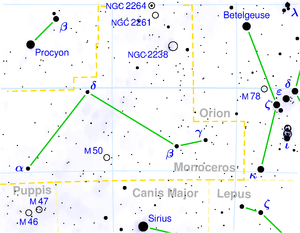
ζ Mon - Optical double star. The primary component has a brightness of 5mag, its companion has a brightness of 8.5mag. It is located at a separation of 66.4". Another companion can be found at a distance of 32". We need a telescope with a 7cm diameter objective.
ε Mon - At the main star with a brightness of 4.5mag, there is a companion at a separation of 13.4" with a brightness of 6.5mag, which can be observed even with a smaller telescope. Both components have a yellow color. At a distance of 93.7" from them, a faint blue companion with a brightness of 12.7mag can be revealed with a larger telescope.
β Mon - The brightest star of the constellation has an apparent magnitude of 3.95. It belongs to a beautiful triple star system discovered by W. Herschel in 1781, whose all blue-white components can be resolved even with small telescopes as a small triangle. Two components with magnitudes of 4.7 and 5.2 are located at a separation of 7.3 arcseconds. A companion with a magnitude of 6.1 is situated at a distance of 2.8 arcseconds from the first component. The system is approximately 700 light-years away. With a larger telescope, we can also discover a star with a magnitude of 12 at a separation of 25.9 arcseconds. This entire system is designated as 11 Mon.
Plaskettova hviezda - Astronomický text:
A spectral binary star of sixth magnitude, discovered in 1922 by Canadian astronomer and director of the Victoria Observatory, John Stanley Plaskett. It is the most massive known binary star.
Překlad českých zkratek světových stran:
N - North W - West S - South E - East
NGC 2237
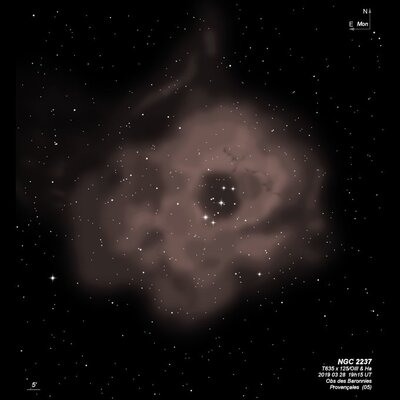
Albert Marth discovered NGC 2238 = m 99 on 28 Feb 1864 with Lassell's 48" reflector on Malta. This is a small, nebulous area around a star in the western half of the Rosette Nebula but there was no mention of the entire nebula, which was first recognized by Lewis Swift and E.E. Barnard.
200/250mm - 8" (1/1/84): complete annulus easy visible in field at 42x or in 8x50 finder with filter as a large, soft ring surrounding the cluster.
300/350mm - 13.1" small knot on the west side of the Rosette Nebula. See NGC 2237 for description.
Naked-eye - (1/8/00): using an OIII filter, the apparent diameter of the cluster (NGC 2244) noticeably increases in size due to the surrounding nebulosity becoming visible. The overall brightness, though, is slightly decreased with the filter as the cluster is significantly dimmed.
Notes by Steve Gottlieb
NGC 2264
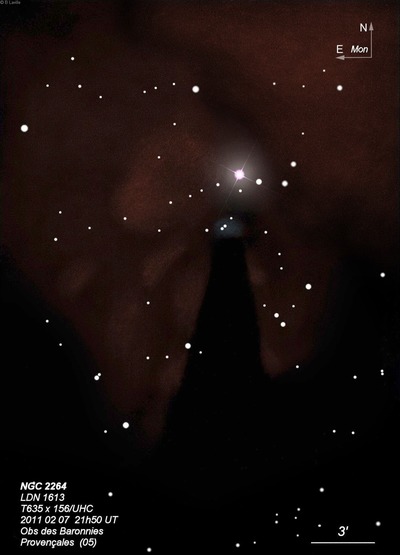
William Herschel discovered NGC 2264 = H V-27 = H VIII-5 = h401 on 18 Jan 1784 (sweep 81) and recorded VIII-5 as "The 15th Mon is attended by above 30 considerable stars, and is itself a double star of the 3rd class. The star extremely unequal and probably not visible in smaller instruments. There is also another double star of the 3rd class not far from it consisting of equal stars." On 26 Dec 1785 (sweep 494) he logged V-27 as "I observed about 7' or 8' sp 15 Mon, some of the pB stars to be contained within vF milky nebulosity which loses itself imperceptibly; but there remains a doubt of the reality." On the 28 Dec 1785 (sweep 496) he mentioned "I examined the stars south preceding 15 Mon and believe they contain Milky nebulosity. It is very difficult to ascertain it on account of the glare of the 15th, but I have hardly any doubt. Again on 11 Jan 1787 (sweep 682) he noted "I suspect the sp 2 stars (of which one is Double [15 Mon] to be affected with vF milky nebulosity but may be a deception." WH's descriptions and position apply to the cluster and to the brightest part of the nebulosity southwest of mag 4.7 S Monocerotis. John Herschel also reported on 18 Jan 1828 (sweep 120), "a *5.6 enveloped in a nebulous haze.", although he may have just seen scattered light around the bright star.
The region around 15 Mon was examined a number of times at Birr Castle, searching for nebulosity. There were 9 negative results before 1861 and Lord Rosse wrote "No neby. Found, and only a few stars arranged in pairs; no cl. Has there been a change here? Heinrich d'Arrest also missed seeing nebulosity in 1862 at Copenhagen with the 9" refractor. But successful observations were made at Birr Castle in 1863 and 1878 (the later by Dreyer). E.E. Barnard and Roberts reported extensive nebulosity in the region based on photographs.
On 10 May 1895 Isaac Roberts showed a three-hour exposure of the NGC 2264 complex taken with his 20-inch reflector on 13 Feb to a meeting of the Royal Astronomical Society. It clearly showed the nebulosity southwest of S Mon (first photographed by Barnard in 1894) but also revealed a “conical dark space bounded by a rim of nebulosity” — this is the famous ‘Cone Nebula’.
200/250mm - 8" (11/5/83): bright, very large, scattered, Christmas tree outline, fairly rich, includes multiple star south Mon.
300/350mm - 13" (11/5/83): very bright, very large scattered group, elongated N-S, striking Christmas tree shape. A bright multiple star 15 Monocerotis = south Mon (4.7-7.5 at 2.8" and companions) is at the base of the tree at the north end of the cluster and is surrounded by several stars. Easy nebulosity is visible which extends 10' SW of south Mon and includes a group of three brighter stars. At the south end of the cluster is the double star ∑954 = 7.1/9.6 at 13". The Cone nebula (not seen) extends south of ∑954 and "points" towards ∑954.
400/500mm - 17.5" (12/28/00): besides the bright nebulosity extending southwest of mag 4.7 S Monocerotis (15), most of the central region of the cluster was set against a weakly glowing background (part of Sh 2-273). At the southern end of the cluster (tip of the "Christmas Tree"), this low surface brightness glow was more evident and clearly extended beyond the 7th magnitude star at the tip towards the SE. The west edge of this weakly glowing extension forms the eastern border of the dark Cone Nebula (LDN 1613). There is a lack of faint stars within the region of the Cone Nebula but the inclusion itself was not darker than the general background.
17.5" (12/30/99): nebulosity was quite prominent to the SW of south Mon as well as a weaker glow in the vicinity around ∑954 at the south end of the cluster. At 100x (unfiltered) there appeared to be a slightly darker vacuity to the south of this star in the position of the Cone nebula but there is no sharp "edge" with the nearby nebulosity.
Naked-eye - (1/8/00): vislble as a 4th magnitude nebulous glow including the mag 5 star (S Mon), but appears much smaller naked-eye than the listed dimensions.
Notes by Steve Gottlieb
M 50
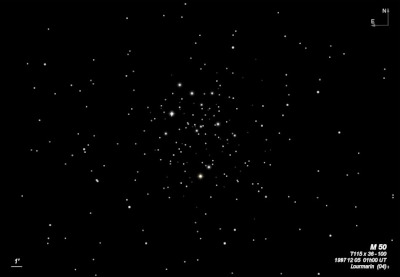
Giovanni Domenico Cassini possibly discovered M50 = NGC 2323 = h425 around 1711. Charles Messier independently discovered the cluster on 5 Apr 1772. William Herschel described the cluster (unpublished) on 4 Mar 1785 (sweep 377) as "a very brilliant cluster of large stars, considerably compressed and rich, above 20' in diameter, the stars of various sizes, visible in the finder."
300/350mm - 13.1" (3/24/84): ~75 stars including some brighter stars at the south and northeast borders. There are a few dense spots and many stragglers. An orange/red mag 8 star is at the south edge and a nice 16" pair of mag 9/11 stars (h748) is 1' NW. There is an elongated 4'x3' region that is devoid of stars just north of the colored mag 8 star. Located 42' E of mag 6.0 HD 52312.
400/500mm - 18" (3/15/10): very bright, fairly scattered cluster, though contains a richer subgroup. About 125-150 stars were resolved at 175x in the central 10'-12'. The cluster has roughly a triangular or wedge-shaped outline, highlighted by an 8' string of stars oriented ~E-W on the north side (including mag 9.0 HD 52965) and a longer 10' string oriented NW-SE on the SW side that includes the brightest cluster star - distinctly orange mag 7.8 HD 52938 near the SE end of the string. Along this string are also four easy pairs of stars. There is a rich circular group of stars, ~5' diameter, a little north of center. On the east side of the cluster is an unequal double, h748 = 8.5/11 at 15". A faint, unequal pair of stars, BRT 392 = 11.5/11.6 at 4", is due west of the unequal pair by 3.5' at the edge of the rich group of stars. A number of stragglers extend out the cluster increasing the size significantly and a scattered group with some brighter stars including mag 9.0 HD 52720 appears detached to the NW.
Notes by Steve Gottlieb
NGC 2261
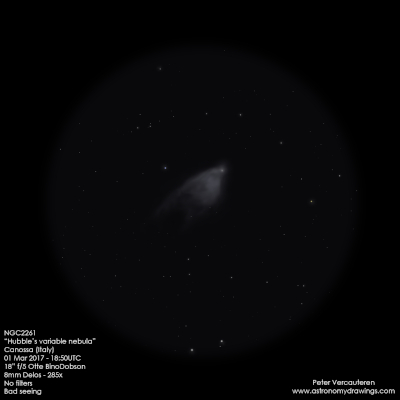
William Herschel discovered NGC 2261 = H IV-2 = h399 on 26 Oct 1783 (very early sweep 67) and recorded "a curious nebula of a fan shape." His summary description (based on 4 observations) reads "cB, fan-shaped, about 2' long from the centre." His placed it in class IV, which includes planetary nebulae. John Herschel reported on 8 Jan 1828 (sweep 118), "*12m with bright cometic branch 60" l whose axis is 60° np. The star is a little ill-defined. The apex of the neb comex exactly up to star, but does not pass it."
Lord Rosse and/or assistant George Johnstone Stoney first observed NGC 2261 on 22 Dec 1848 and again on 11 Feb 1849. Rosse or Stoney sketched the nebula on 16 Jan 1850 (plate XXXVII, figure 10) and noted "two comparatively dark spaces, one near the vertex and other near the base of the cone." William Lassell observed and sketched NGC 2261 in March 1853 with his 24-inch equatorial reflector from Malta. He noted, "the nucleus not stellar, but like the nucleus of the nebula in Andromeda [M31]." Father Angelo Secchi published a detailed sketch and description in 1856 using the 9.6" refractor in Rome.
Julius Schmidt discovered the variability of R Mon in 1861 with a 6" refractor. While a graduate student at Yerkes Observatory in 1916, Hubble discovered the nebula itself was variable, hence the popular nickname. A series of photographs chronically the changes were taken with the 30" Reynolds reflector between 1916-1920 at the Helwan Observatory in Egypt. This is an unusual bipolar nebula with the second southern jet hidden from view. According to the California Institute of Technology, Hubble's Variable Nebula was the first object photographed through the 200-inch Hale telescope at Palomar Observatory. Hubble sat in the prime focus cage of that instrument and recorded an image on 26 Jan 1949.
200/250mm - 8" (1/28/84): comet-like nebula extends from R Mon.
300/350mm - 13.1" (1/28/84): Hubble's Variable Nebula is bright, small, fan-shaped 2:1 N-S and widest at the north boundary. The nebulosity tapers down towards 12th magnitude R Monocerotis at the south tip which appears to have a very small high surface brightness halo. The western edge (oriented NW-SE) is slightly weaker and more curved than the eastern edge which is sharper and straighter N-S. This is an impressive nebula with high surface brightness and interesting structure.
400/500mm - 18" (3/4/08): Hubble's variable nebula is a striking fan-shaped object, with a mag 12 "star" at its south tip with the nebula extending to the north. The fan displays a great deal of variation in brightness and structure at 300x. The brightest portion is on the northwest side of the fan, though it dims a little near the tip on the west side. The eastern rim is bright and sharply defined N-S like a thin finger. The nebulosity dims along the northern end of the fan and a small, wedge-shaped darker area extends into the fan from the north.
900/1200mm - 48" (5/1/19): at 375x; the view through this scope showed a great deal of structure and brightness variations. I was struck by the length of the eastern edge, which dimmed after the bright thin section extending north, but could be traced just beyond two mag 17-17.5 stars, for a total length of 3'.
Notes by Steve Gottlieb
IC 2177
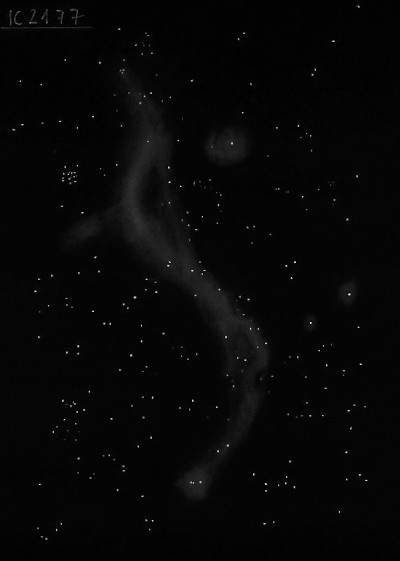
Off the south side is the smaller nebula Ced 90. At 64x it appeared as a faint, round, 3' haze surrounding a mag 8.5 star. Two mag 10.5 stars are collinear off the east side, 2.5' and 3.3' from the center and several mag 12 stars are involved at the south edge. The H-beta filter noticeably improves the contrast and makes the nebulosity a moderately bright, direct-vision object. With averted vision the glow increases to 4'-5' in diameter with some very faint haze extending east. The star density drops off immediately to the west, except for a few stars. Ced 90 is located at the extreme southern tip of the 2.5 degree giant emission nebula IC 2177, which extends north into Monoceros. This is one of a select group of low-excitation nebulae that can be added to the list of H-beta objects.
Isaac Roberts discovered IC 2177 photographically in 1898 surrounding mag 7.3 BD-10 1848. His position (for the mag 7 star) and dimensions of 13' corresponds with the position of vdB 93 = Gum 1 = Sh 2-292, not the 2° N-S strip of nebulosity that is commonly identified as IC 2177 in modern catalogues! The often photographed strip was discovered by Max Wolf in 1905. See Corwin's comments for the full story!
It was also found on a photograph taken on 1 Apr 1911 by Harry Wood at the Transvaal (Union) Observatory with the 10-inch Franklin-Adams camera. Woods described it as a "large faint straggling region, about 2 1/2° long." He added "BD -10° 1848 is involved in a bright patch of nebulosity, in which there are two large holes on the S side of the star." This description refers to Gum 1 (photographed by Roberts). He also noted "BD -12° 1771 is a nebulous star with an extension of the nebulosity on the Nf side; it looks like a comet." This description refers to Sh 2-297 at the southern end of the region.
300/350mm - 13.1" (1/19/85): at 62x and UHC filter appears as a very large, very elongated strip of nebulosity. At the north end is the open cluster NGC 2335 within Monoceros. The southern portion is difficult to trace; it crosses into Canis Major and ends at an easily visible reflection nebula = Ced 90 surrounding a mag 8 star. Also includes nebula NGC 2327 midway along the length. This emission/reflection nebula is referred to as the Eagle or Seagull Nebula.
400/500mm - 17.5" (2/2/02): On the NW side is a circular nebulosity (the head of the Seagull) catalogued as Gum 1 = vdB 93 = Sh 2-292. At 100x it appeared as a very large, circular glow perhaps 15' in diameter of low surface brightness surrounding mag 7.1 V750 Mon with vague hints of structure. The OIII filter gave only a very weak enhancement, but the H-beta filter noticeably improved the contrast at low power. This combination HII/reflection nebula is situated off the NW end of the huge winding IC 2177 strip that extends mostly to the south, and is a wonderfully rich region of the Milky Way with a number of clusters and star groups in the vicinity.
Notes by Steve Gottlieb
NGC 2232
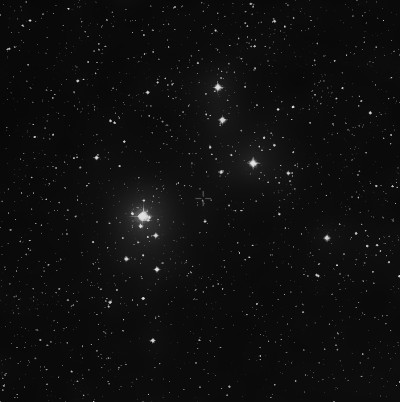
William Herschel discovered NGC 2232 = H VIII-25 on 16 Oct 1784 (sweep 296) and recorded "The 10 Monocerotis surrounded by many bright stars." His position matches the bright star. The position in the Lynga catalogue, RNGC, NGC 2000.0 and Sky Catalogue 2000 is about 20' too far west! Brian Skiff suggests a centroid position of 06 28 02 -04 50.8 based on the star GSC 4793-2505. See my RNGC Corrections #7.
By analyzing William Herschel's earlier "reviews" of bright stars (before his systematic sweeps), which resulted in the discovery of many double stars, Wolfgang Steinicke found that Herschel discovered the cluster on 5 Dec 1779 using his 6.2" reflector. This is apparently his earliest non-stellar discovery!
400/500mm - 17.5" (12/28/94): at 100x appears as a scattered group of bright stars surrounding 10 Monocerotis (V = 5.1) with the remaining stars forming a wedge tapering to the SW. Includes 7 brighter mag 8-10 stars and another two dozen fainter stars. Richest surrounding 10 Mon and five brighter stars form a distinctive box around the bright star. Too large and scattered for higher power.
Notes by Steve Gottlieb
NGC 2301
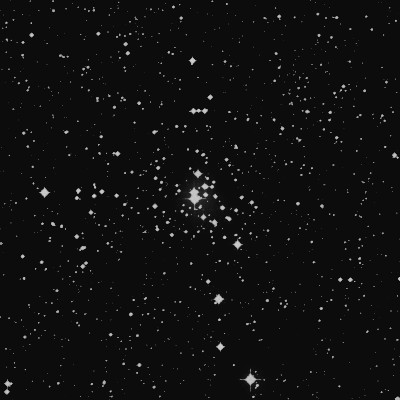
William Herschel discovered NGC 2301 = H VI-27 = h413 on 27 Dec 1786 (sweep 668) and described "a very beautiful cluster of much compressed small and large stars of many sizes, above 20' diameter." His position is accurate. On 27 Jan 1832 (sweep 397) John Herschel noted, "double star in the chief group of a prety rich coarse cl, not very compressed. Broken into 3 groups. The sp group is the richest."
300/350mm - 13.1" (1/1/84): striking, ~60 stars in cluster, dozens more nearby. A very elongated string passes through the center.
400/500mm - 17.5" (2/28/87): ~60-70 stars in cluster. A bright blue/yellow double star (h740 = 8.6/9.3 at 21") is near the center. Many of the stars are arranged in two strings oriented SW-NE which pass through the center.
Notes by Steve Gottlieb
NGC 2506
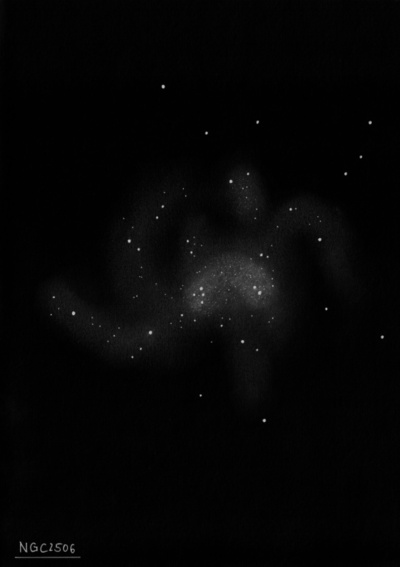
William Herschel discovered NGC 2506 = H VI-37 = h480 on 23 Feb 1791 (sweep 995) and recorded "a very compressed and very rich cluster of stars. The stars are of 2 sizes, some considerably large and the rest next to invisible. The compressed part 5' or 6' in diameter." His position (Auwers' reduction) is 7' NNE of center of this cluster. It was independently found by Karl Ludwig Harding around 1823 and reported it as a new discovery.
John Herschel's described the cluster on 9 Mar 1828 (sweep 129) as "the first *11m in the p part of a rich resolved p comp cl irreg fig; *s 11...20m, so as to be nebulous. The most comp part = 4' or 5' diam. His Slough position is accurate, but he subtracted 10' in North Polar Disatance in the GC (General Catalog) assuming he made an error, as his position didn't match his father's or Harding's. See GC and NGC notes.
Lord Rosse, or his observing assistant George Stoney, commented on 27 Jan 1849 "More approach towards spiral appearance than I have seen in any other cluster [obvious spiral shapes were a primary focus]. Very curious black spaces with power 700x."
300/350mm - 13" (2/23/85): at 220x, ~35 stars visible, many in a winding row. A number of brighter mag 11 stars surround the group.
400/500mm - 17.5" (3/12/94): 75 stars in 10' diameter at 220x. The brightest members are a wide pair of mag 11/12 stars at the west end with a separation of 27" oriented SW-NE and a mag 11.5 star at the east end. Rich in mag 13-14 stars with a roughly circular outline except for a "bite" on the south side. The richest subgroup is following the two brighter stars at the west end and is 3' diameter forming a "C" shaped asterism opening to the south over haze and is quite striking.
Notes by Steve Gottlieb
NGC 2252
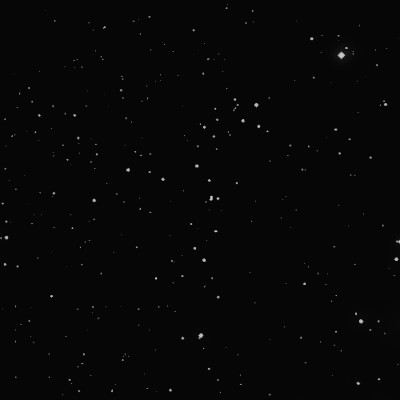
William Herschel discovered NGC 2252 = H VIII-50 = h396 on 27 Jan 1786 (sweep 512) and reported "a cluster of stars arranged in a broad row, 25' long and 6 or 8' broad, not very compressed but pretty rich." His position is on the east side of the cluster. John Herschel logged in Mar 1830 (sweep 237), "L, pretty rich; stars small; place by working list."
400/500mm - 18" (3/13/04): at 115x, this fairly rich field is located just 50' NE of the center of the Rosette Nebula! Most distinctive in the field is a very elongated N-S group of roughly 50 stars in a 12'-15' string just 2' wide. The group has a distinctive hook on the north end as it curves sharply towards the SW. A near perfect triangle of mag 9 stars at 30", 34" and 40" separation lies 23' E.
Notes by Steve Gottlieb
NGC 2236
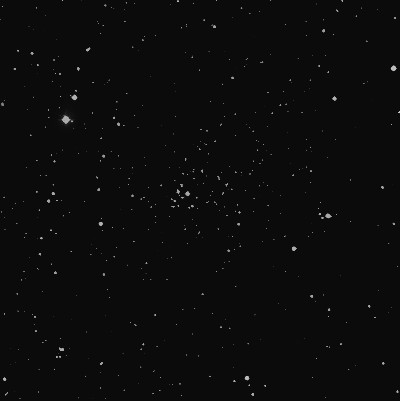
William Herschel discovered NGC 2236 = H VII-5 = h390 on 23 Feb 1784 (sweep 156) and described "a cluster of compressed stars of various magnitudes, pretty rich in small stars; the preceding part contains chiefly large onces, not round." On 8 Jan 1828 (sweep 118) John Herschel described an "Irreg fig cl like a hollow triangle in a crowded part of the Milky Way; stars vS; 12...15m; one star 10m. The surrounding loose stars are all large."
300/350mm - 13.1" (1/18/85): two dozen faint stars in a 5' region over background haze. The brighter stars are in a rich 1' triangular outline with the brightest mag 11 star in the cluster. A long curving arc of fainter stars emanates from the group. Fairly striking cluster.
Notes by Steve Gottlieb
NGC 2346
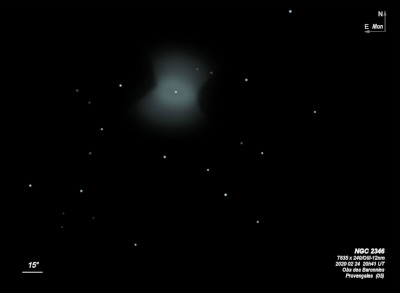
William Herschel discovered NGC 2346 = H IV-65 on 5 Mar 1790 (sweep 935) and recorded "a pretty considerable star, 9 or 10m, visibly affected with vF nebulosity, of very little extent all around. A power of 300 shewed the same, but gave a little more extent to the nebulosity. The 22d Monocerotis was quite free from nebulosity." CH's reduced position is 1° too far south, but a note was added on the sweep there may be an error of 1°, due to a confusion on the polar distance.
John Herschel didn't report an observation in either his Slough or Cape catalogues. Dreyer observed the PN on 14 Feb 1877 with the 72" at Birr Castle and reported "*9 mag seems nebulous, especially on the n or np side. At last we agreed that it was nebulous all round. About 4' sp is a reddish *10 with a white-bluish *11 1' south. The nebulous star has a bluish tint."
300/350mm - 13.1" (1/11/86): bright mag 11.5 central star surrounded by fairly small, round disc. Located between two mag 13 stars 0.8' E and 1.2' W. View enhanced with Daystar 300 filter. Central star is the variable V651 Mon (mag 11.3-13.5).
400/500mm - 17.5" (2/2/02): easily picked up at 100x as a fairly small, round halo surrounding a bright mag 11.5 star. Nice view at 280x and 380x. The halo is irregularly round, ~50"x45" with a slightly uneven surface brightness and it appears a bit thinner or pinched on the NW side. Modest contrast gain with a UHC filter at 100x-280x, although this object does not require a filter.
Notes by Steve Gottlieb
NGC 2149
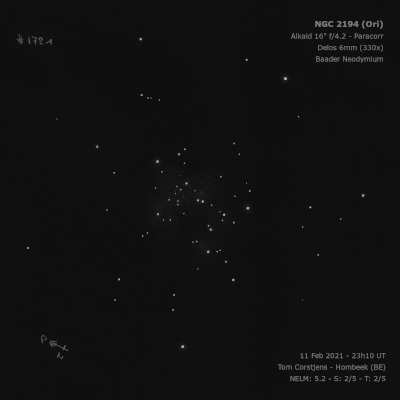
Édouard Stephan discovered NGC 2149 = St VIIIb-18 on 17 Jan 1877 with the 31" refractor at Marseille Observatory. His position is accurate. NGC 2149 was misclassified as a galaxy in the 1932 Shapley-Ames Catalog. It was found to be a star + galactic nebulosity by Mayall and communicated privately to Shapley in 1952. It was deleted as a galaxy in the 1964 Reference Catalogue of Bright Galaxies (de Vaucouleurs). Still it was erroneously plotted as a galaxy on the Skalnate Pleso Atlas of the Heavens.
400/500mm - 17.5" (1/19/91): this moderately bright reflection nebula is fairly small and has a 12th magnitude (illuminating) star on the west side. Appears prominent with an OIII filter(?) at 140x.
Notes by Steve Gottlieb
NGC 2260
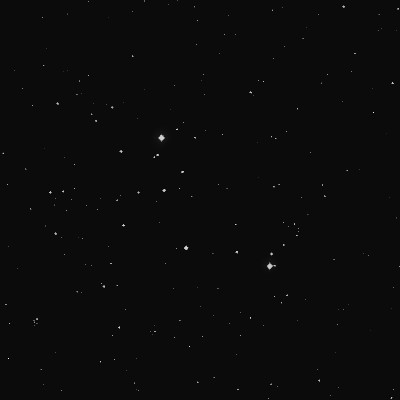
William Herschel discovered NGC 2260 = H VIII-48 = h398 on 1 Jan 1786 (sweep 506) and noted "A Cl of very scattered stars of various sizes, of more than 1/2 degree of extent." On 23 Nov 1827 (sweep 107) John Herschel reported, "very course, v poor, v straggling, the chief *8 taken." His position corresponds with mag 8.2 SAO 133505 at 06 38 05.8 -01 26 40. Karl Reinmuth gave an approximate size of 15' with description "Cl, pL, P, st 8..." based on its photographic appearance on Heidelberg plates. The group is not included in the Lynga cluster catalogue and RNGC classifies it as nonexistent (Type 7).
400/500mm - 17.5" (2/1/03): roughly 50 stars are visible at 100x spread out over 15'. The stars are in two main subgroups, oriented SW and NE. The SW group includes mag 8.0 SAO 133489 with a rich arc of stars trailing to the north. The NE group is highlighted by mag 7.1 SAO 133505 with a nice 20" mag 11/12 double 1.5' SSE. Also an isolated mag 8.3 star is at the southern vertex of an obtuse triangle with these two groups. Listed as nonexistent in the RNGC.
Notes by Steve Gottlieb
NGC 2270
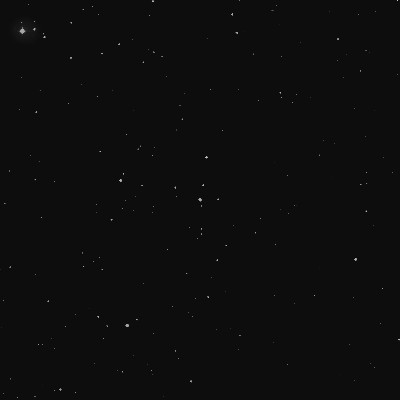
William Herschel discovered NGC 2270 = H VII-36 = h405 on 26 Dec 1786 (sweep 667) and noted "A Cl of very scattered stars, considerably rich, and of great extent." On 2 Feb 1831 (sweep 320) John Herschel logged a "coarse scattered cluster; not very rich; place of *9m." His position is just 5 tsec east of mag 8.8 SAO 114331 at 06 43 51.7 +03 27 12. Based on its photographic appeared, Reinmuth calls this a "rich region, no distinct Cl." RNGC classifies the number as nonexistent. See Harold Corwin's identification notes.
400/500mm - 17.5" (2/1/03): this is a large, scattered field, ~10' diameter surrounding a kite-shaped asterism of mag 8.5-10 stars. There is no concentration but there are a couple of denser clumps of faint stars on the east side. A curving string of stars heads NE and ends at a group of stars surrounding mag 7.6 SAO 114355. Located 30' S of a mag 5.9 star. Does not appear to be a cluster but just a Milky Way field. Listed as a nonexistent cluster in the RNGC.
Notes by Steve Gottlieb
NGC 2343
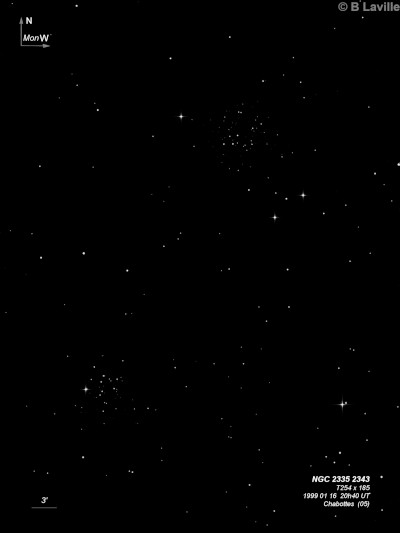
William Herschel discovered NGC 2343 = H VIII-33 on 10 Jan 1785 (sweep 356) and called it "a cluster of scattered large stars, not so extensive as the last [NGC 2335], nor so rich." His position is just off the southeast side of the cluster.
400/500mm - 17.5" (3/20/93): two dozen stars mag 8-13 in compact 5' diameter. The cluster has a distinctive boxy shape but is not rich. Includes an unequal double star ∑1028 = 8.8/11.1 at 11" at the east side. Stars are arranged in small subgroups with no central concentration, well detached in field. Located off the NE end of the huge, strip of nebulosity IC 2177.
Notes by Steve Gottlieb
NGC 2353
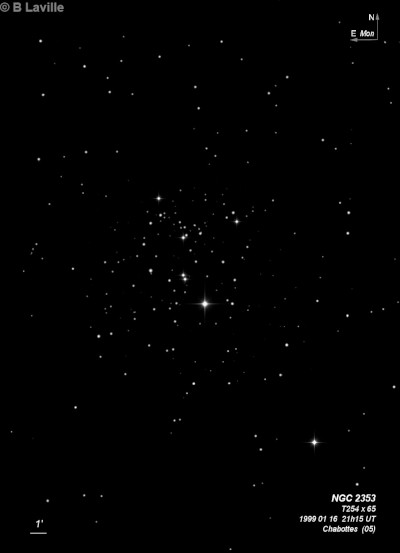
William Herschel discovered NGC 2353 = H VIII-34 on 10 Jan 1785 (sweep 356) and noted "an extensive scattered cluster contains a very bright star."
400/500mm - 17.5" (3/20/93): over 100 stars mag 6-13 in a 20' diameter, requires 100x (20mm Nagler) for best view. Richest around mag 6 SAO 152598 on the south side where 50 stars are in a 8' rectangular outline. A bright double star ∑1052 = 9.1/9.3 at 20" is located just 2' NE of the mag 6 star and two mag 9 stars are at the NW and NE corners of this subgroup. Surrounding this group is a dark ring devoid of stars and then beyond is a fairly rich outer annulus including several mag 9-10 stars.
Notes by Steve Gottlieb
NGC 2335
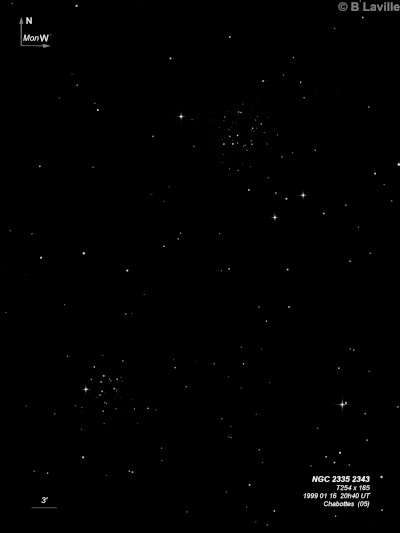
William Herschel discovered NGC 2335 = H VIII-32 on 10 Jan 1785 (sweep 356) and reported "a cluster of coarsely scattered stars of many sizes, pretty rich, more than 15' diameter." His position is on the west side of this open cluster.
400/500mm - 17.5" (3/20/93): 50-60 stars mag 10.5-14 in a 10' diameter. Mag 6.9 SAO 134220 is 10' NE of the core. In the center is a 1' parallelogram formed by four mag 10.5-12 stars with parallel sides oriented E-W and NW-SE. There are no dense areas (overall has a fairly scattered appearance) although the cluster includes several subgroups. A wide mag 12 double is on the north side. Located at the north tip of the huge emission nebula IC 2177.
Notes by Steve Gottlieb
NGC 2302
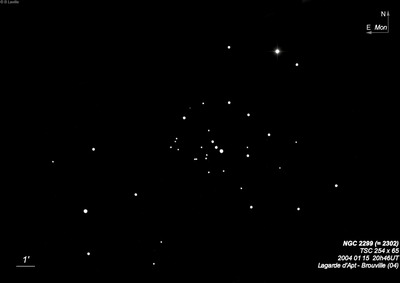
William Herschel discovered NGC 2302 = H VIII-39 = h414 on 4 Mar 1785 (sweep 377) and recorded "a cluster of scattered large stars, of various sizes, not very rich; but taking up above 20 minutes." His position was ~20 seconds of RA too large, though his description included the surrounding field. NGC 2299 is a duplicate observation (see notes).
400/500mm - 17.5" (2/1/03): at 140x, this a fairly small group (~4' diameter) of roughly two dozen stars embedded in a large, scattered field of stars. On the west side is a nice quadruple including three mag 10 stars. On the east side is a double and a triple star forming a "V" asterism. Located 7' SE of mag 6.6 SAO 133781. This bright star has perhaps a dozen fainter stars within 3' but this subgroup does not look to be a plausible candidate for NGC 2299 which is more likely a duplicate of NGC 2302.
17.5" 20 stars resolved at 140X, in fairly small group. Not rich but includes some close doubles. The three brightest mag 10 stars form a shallow arc on the west side with fourth fainter star nearby. On the east side is a V-shaped group of six stars with the vertex at the east side. The central portion includes a few scattered stars with a line of three stars on the south side.
Notes by Steve Gottlieb
NGC 2311
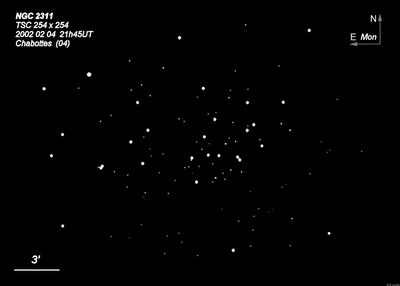
William Herschel discovered NGC 2311 = H VIII-60 = h418 on 26 Nov 1786 (sweep 639) and described "a cluster of pL scattered stars, not very rich. The place taken is the most compressed part, but not the middle. May be a projecting point of the milky way." His position was just northeast of center of this cluster.
400/500mm - 17.5" (1/1/92): three dozen stars mag 11-15 in 5'x2' region elongated ~N-S. Fairly rich though no dense spots. Most stars form a thin isosceles triangle with the vertex star mag 13 at the north end, although the brightest star is a wide double 2' ESE of the vertex. From the base of the triangle a stream heads SE and then east from the cluster mixing with some brighter field stars. The cluster includes a few close faint double stars.
Notes by Steve Gottlieb
NGC 2245
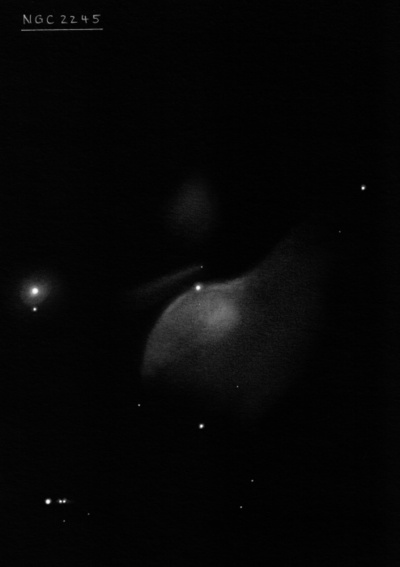
William Herschel discovered NGC 2245 = H IV-3 = h393 on 16 Jan 1784 (sweep 81) and reported "A nebula. It is fan shaped, and appears like a star with a faint, electric brush at one side of it." On 18 Jan 1828 (sweep 120), John Herschel called it "a *11 with a milky neb surrounding it, but chiefly on the sp side. The star is not sharp - not stellar, and the neb fades gradually away from the star; 70" or 80" diam; has a * 7m 30° nf."
The account by Lord Rosse (or assistant George Stoney) on Feb 28 1850 is remarkable: "...this neb is part of an enormous neby, which I traced following and north to a great distance, some degrees. It narrows at times to a band across the finding eyepiece of about 6' or 8'. I fancied the number of bright stars was greater in it than in the neighborhood; I am certain the number of small stars is much less..." A sketch made was included in Lord Rosse's 1861 publication (plate XXVII, fig 11).
400/500mm - 17.5" (1/19/91): bright, fairly large, about 3' diameter, elongated SW-NE. Fans out to the southwest from a fairly bright mag 11 star at the northeast end. Fades smoothly into background. Located 2' WSW of mag 8.0 SAO 95816. Reflection nebula NGC 2247 lies 12' NNE.
Notes by Steve Gottlieb
NGC 2282
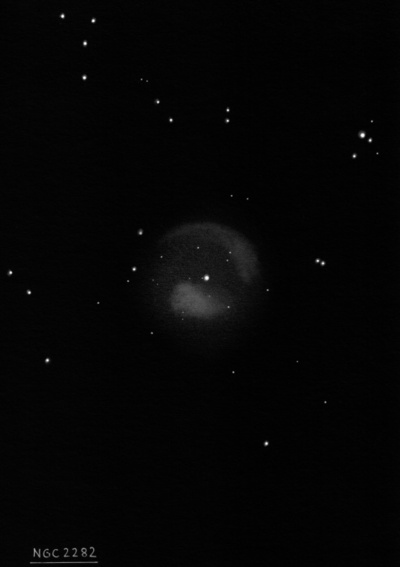
300/350mm - 13.1" (1/18/85): very faint reflection nebula with a mag 10 star involved, fairly small, round.
Notes by Steve Gottlieb
NGC 2316

Bindon Stoney or his brother George Johnstone Stoney discovered NGC 2317 on 20 Feb 1851. NGC 2316 was described as a "S close D neb, below 3 st, 2 stellar points (or nuclei)." The nebula was sketched on 23 Nov 1851 and included in Lord Rosse's 1861 publication. The RA was only roughly given in the GC and the NGC (nearest min of RA). The RNGC misclassifies this number as nonexistent although NGC 2317 is part of NGC 2316. Pietro Baracchi also sketched it as a double star in nebulosity on 16 Mar 1885 with the 48" Melbourne telescope. Hermann Kobold measured accurate positions for both "nuclei" in 1895 (published in his 1907 catalogue).
300/350mm - 13.1" (2/25/84): moderately bright nebulosity, small, surrounding the northeast of two stars (separation ~11"). An obtuse triangle of mag 12 stars is just 1' S. Enhanced with a Deep Sky filter.
Notes by Steve Gottlieb
IC 446
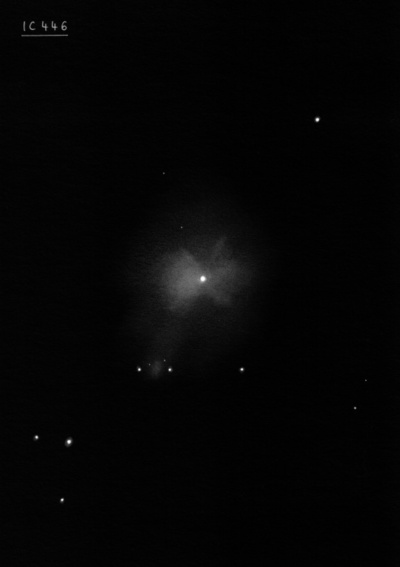
E.E. Barnard visually discovered IC 2167 = IC 446, along with IC 2169, on 11 Oct 1888 with the 12-inch refractor at Lick Observatory. He noted "a 9 1/2 mag star with largish faint nebula, a little heavier following."
He later found it again photographically on 24 Jan 1894 with the Willard 6" lens and announced it in "Photographic Nebulosities and Star Cluster Connected with the Milky Way" (Astronomy and Astrophysics, Vol XIII, No 3). Based on this discovery note, Dreyer catalogued it as IC 446. Barnard states, though, he first found it visually around 1888 "while sweep over this region..I also found a 10 mag nebulous star about half a degree north preceding 2245." His position in this paper is accurate. Apparently Barnard also sent Dreyer his original visual discovery, so IC 2167 is based on his earlier visual discovery. This object is a bi-polar reflection nebula. Listed in article on bi-polar nebulae by Ronald Stoyan in Deep Sky Observer #12.
400/500mm - 17.5" (1/23/93): fairly faint reflection nebula surrounds a mag 10-11 star. This bi-polar nebula is fairly large, about 2.5' diameter. Appears to extend further (or is brighter) on the south side. Bordered by three collinear mag 13 stars on the south side.
Notes by Steve Gottlieb
IC 466
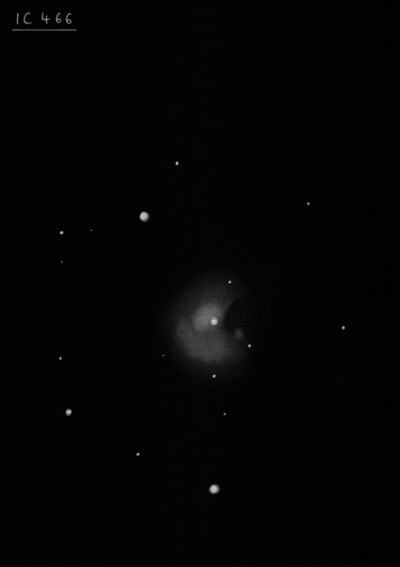
Stephane Javelle discovered IC 466 = J 2-616 on 18 Feb 1893 with the 30-inch f/23 refractor at the Nice Observatory. His micrometric position is accurate.
400/500mm - 17.5" (2/28/87): mag 12.5 star in an easy, very small, round nebulosity. Located 1.5' SSW of a mag 10.5 star. A wide pair of mag 10 stars lie 7' SW. Enhanced with a UHC filter at 220x.
Notes by Steve Gottlieb
NGC 2239
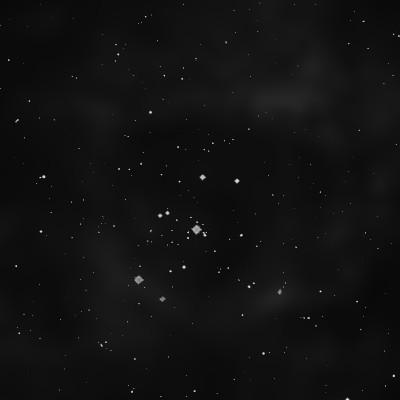
William Herschel discovered NGC 2244 = H VII-2 on 24 Jan 1784 (sweep 114) and described "the 12th Monocerotis is a beautiful scattered cluster of stars. They are chiefly of two sorts; the first very brilliant, and the 2nd sort arranged in beautiful winding lines; of these there are about 30 or more. There are besides many very small stars." Wolfgang Steinicke reports that Herschel first observed the cluster earlier on 13 Jan 1783 (before starting his sweeps) using his 6.2-inch reflector.
John Flamsteed recorded the 6th magnitude star 12 Monocerotis on his Atlas Coelestis (17 Feb 1690). But Stephen O'Meara notes that Flamsteed didn't note any of the fainter cluster stars (or general fuzziness), so doesn't deserve credit for the discovery.
200/250mm - 8" bright, large cluster in the center of the Rosette Nebula. The six brightest stars form a rectangular outline with the brightest star 12 Monocerotis (V = 5.9) at the SE corner. At the north and NW corners of the rectangle are two bright wide pairs with mag 7/8 stars. Many faint stars are near the center surrounding the wide pairs. Faint naked-eye cluster in dark sky.
400/500mm - 17.5" (2/11/96): unusually bright, large cluster of ~15'x5' elongated NW-SE in a rectangular outline and situated in the heart of the Rosette Nebula! The brightest 8 mag 6/7 stars lie along the sides and vertices of the rectangle with the brightest member, yellowish 12 Mon (V = 5.9), residing at the SE vertex. There are ~40 stars within the cluster although the only concentration is fifteen mag 11/12 stars surrounding mag 6.8 SAO 114010 (W of center) and trailing to the east towards the wide bright pair of mag 8 stars east of center (one of these stars is the double STF 926 = 9.2/10.3 at 5").
Notes by Steve Gottlieb
NGC 2251
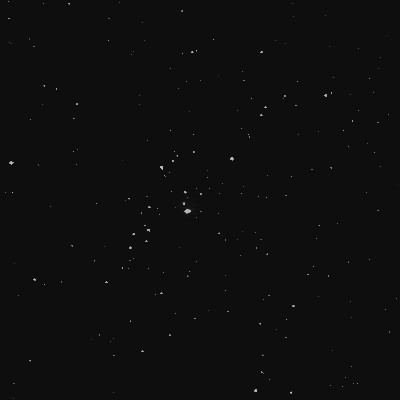
William Herschel discovered NGC 2251 = H VIII-3 = h395 on 26 Dec 1783 (very early sweep 67) and noted "a small cluster of very close stars, not very remarkable." His summary description (2 observatins) reads "an extended cluster of large scattered stars." His position falls just west of center of this cluster. On 8 Jan 1828 (sweep 118), John Herschel logged, "a large tract full of stars; v rich; place from working list."
400/500mm - 17.5" (3/12/94): about 40 stars mag 10.5-14 in an 11'x4' fairly rich string NW-SE. Includes about 10 brighter mag 11 stars. The brightest mag 9.5 star is part of a small, roundish subgroup on the west side and is a pleasing double with components mag 9.5/12 at 10". This subgroup has three brighter stars and 15 faint stars mostly west of the double. The main string is fairly uniform except for an empty 3' gap SE of the mag 9.5 star. Located 5' NW of the cluster is an isolated mag 10 star which appears to be a field star.
17.5" (2/1/92): 35 stars mag 10-14 in 12'x6' string NNW-SSE, bright, moderately large, fairly rich but not dense. Consists of 3 main subgroups. The western group is 2' diameter and includes a close double star 10/12 at 10". The NW group is 3' diameter and includes two mag 11 stars with three mag 13 stars between. The SE group is largest and includes 15 stars in a 6' string very elongated N-S with a close double star.
Notes by Steve Gottlieb
NGC 2286
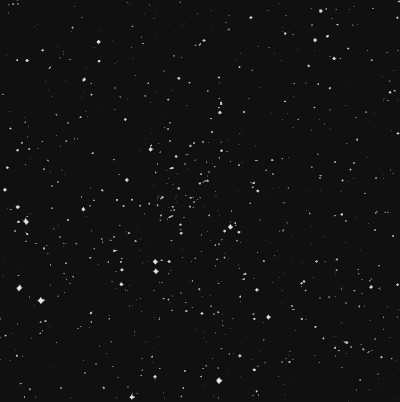
William Herschel discovered NGC 2286 = H VIII-31 = h408 on 6 Jan 1785 (sweep 352) and noted "A larger cluster of scattered stars, not v rich." John Herschel made two observations and noted on 4 Jan 1827 (sweep 41), a "Loose L irreg scattered cl of about 100 st 9...15m."
400/500mm - 17.5" (12/20/95): at 100x, ~40 stars within an arbitrary 10' region, elongated N-S. This is a fairly rich group of mostly mag 12 and 13 stars bordered by brighter stars grouped in pairs and trios. There is some concentration with a richer 4' core. A wide pair of mag 9 stars is off the SE side.
17.5" (2/1/92): ~60 stars mag 11-14 in the central 10' diameter. Bright, large, fairly rich though not dense. Richest in a lane running NNW-SSE over haze although the brightest mag 10 stars are outliers to the W, north and SE. There is also a bright lane 15' length oriented N-S located to the east of the main group which includes several wide double stars.
Notes by Steve Gottlieb
NGC 2215
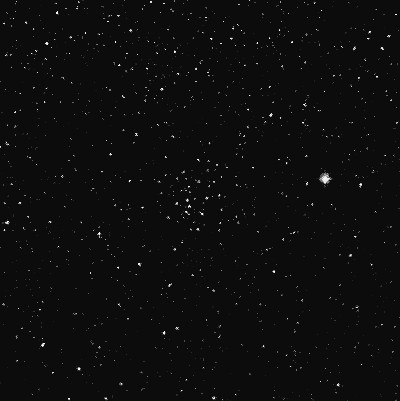
William Herschel discovered NGC 2215 = H VII-20 = h386 on 1 Nov 1785 (sweep 468) and recorded "a cl of coarsely but pretty evenly scattered pS stars, of nearly the same magnitude, coarsely round and about 15' diam." His summary description (based on 3 sweeps) reads "a beautiful cluster of pretty compressed and equally scattered stars, 10' or 12' diameter."
400/500mm - 17.5" (12/28/94): about 50 stars mag 11-14 in a 12' region, pretty evenly distributed and stands out well in the field at 100x. At the west edge is a faint detached group of 8 stars. Near the center are several wide pairs and one close evenly matched fainter pair. The cluster is not well defined on the east side and merges into the general field.
17.5" (2/1/92): 30 stars mag 11-14 in 10' diameter, fairly bright, elongated ~E-W, pretty evenly distributed, fairly rich although there no dense areas. Includes about 10 mag 11 stars but there is no single dominant star. The remainder are mag 12-14. Set over background haze. Stands out well in low power field.
Notes by Steve Gottlieb
NGC 2324
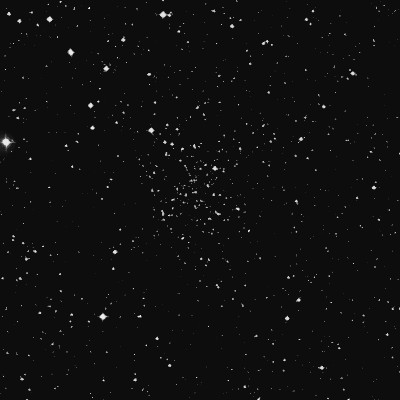
William Herschel discovered NGC 2324 = H VII-38 = h427 on 27 Dec 1786 (sweep 668) and noted "a beautiful cluster of small stars of several sizes, considerably compressed and rich in the middle, 10 or 12' diameter." John Herschel made 3 observations and logged it on 20 Dec 1827 (sweep 113) as a "rich L cl; fills field; st 14...16m; not comp towards a centre."
200/250mm - 8" rich in faint stars 12-13, includes two mag 9 stars.
400/500mm - 17.5" (3/20/93: 65 stars mag 10-14 in very irregular 8' diameter. Includes two mag 10 stars at the NE corner and NW side. Includes several mag 12 stars but rich in mag 13-14 stars. Somewhat uneven distribution of very faint stars due to a couple of 2' diameter dark voids; one near the center. The cluster includes several very close, faint double stars.
Notes by Steve Gottlieb
NGC 2250
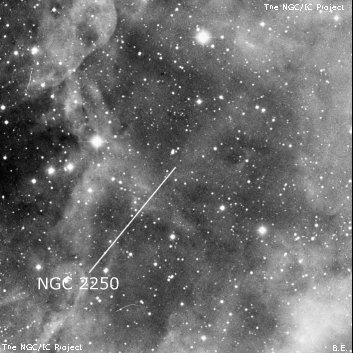
John Herschel discovered NGC 2250 = h394 on 20 Feb 1830 (sweep 235) and wrote, "place of a *8-9 m in following part of a large pretty rich loose cluster; irreg oblong fig; stars 12...14m." His position matches mag 8.7 HD 46576. The Lynga and RNGC position is 1 tmin too far west.
400/500mm - 18" (1/26/09): at 175x about two dozen stars mag 12-14 stars are resolved in an 8'x4' irregular group, elongated E-W. The brightest star is mag 8.7 HD 46576 on the NE end. Includes several pairs, although none are impressive. Set over a glowing Milky Way background. Appears to be just a weak field enhancement not a true cluster.
Notes by Steve Gottlieb
NGC 2254
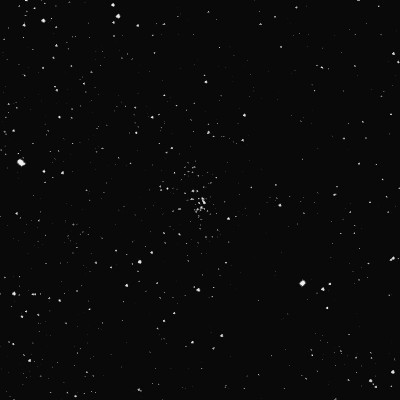
William Herschel discovered NGC 2254 = H VII-22 = h397 on 28 Dec 1785 (sweep 496) and noted "a small cluster of pretty compressed vS stars." His position is just west of center. On 8 Jan 1828 (sweep 118), John Herschel described "a pretty rich, small cluster; irreg fig; st 11...15m."
400/500mm - 17.5" (2/8/91): at 220x, about two dozen stars over haze in a 3'-4' diameter. About 6 stars of mag 13 form a "C" shaped asterism open on the east side. The brightest mag 13 star is on the NW side of this arc. The rest of cluster members are 14-15th magnitude.
Notes by Steve Gottlieb
K 2-2
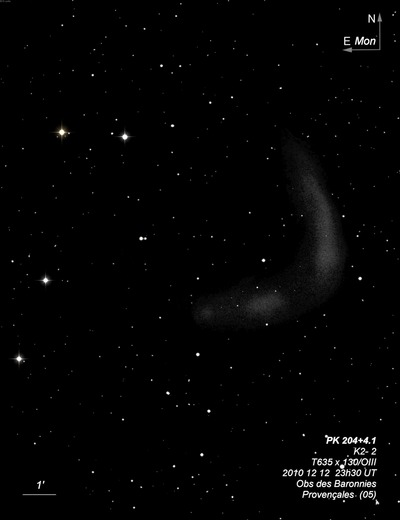
| Type | PN |
| RA | 06:52:23.2 |
| Dec | +09:57:56.0 |
| major_axis | 7.0' |
| mag | 12.5 |
| surface_bright | 16.2 |
M 1-16
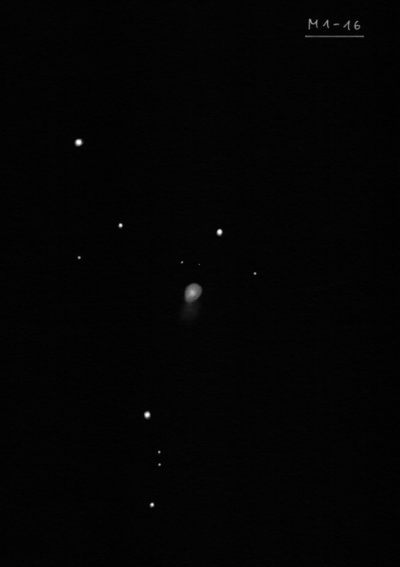
| Type | PN [?(4)] |
| RA | 07:37:18.9 |
| Dec | -09:38:48.0 |
| minor_axis | 30.0'' |
| mag | 13.9 |
| surface_bright | 7.1 |
M 1-8
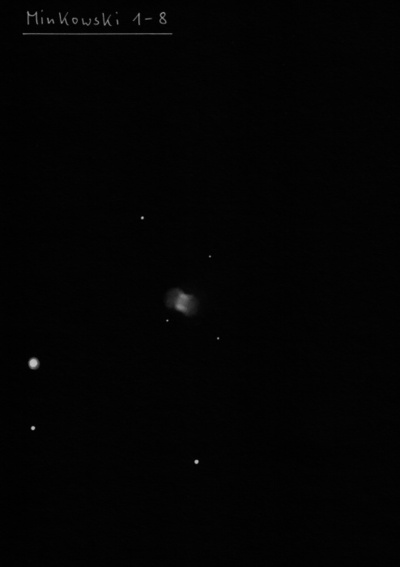
| Type | PN |
| RA | 06:53:33.8 |
| Dec | +03:08:27.0 |
| major_axis | 24.0'' |
| minor_axis | 18.0'' |
| mag | 14.5 |
| surface_bright | 11.6 |
M 3-3
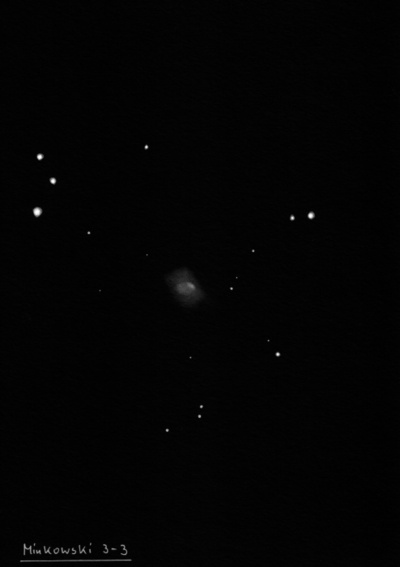
| Type | PN |
| RA | 07:26:34.2 |
| Dec | -05:21:52.0 |
| major_axis | 18.0'' |
| minor_axis | 6.0'' |
| position_angle | 7.0 |
| mag | 14.8 |
| surface_bright | 11.1 |
Abell 17
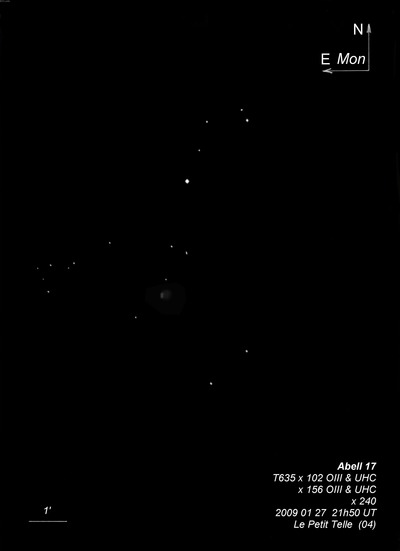
| Type | PN [2c] |
| RA | 06:48:38.0 |
| Dec | -09:32:39.0 |
| major_axis | 54.0'' |
| minor_axis | 36.0'' |
| mag | 14.8 |
| surface_bright | 13.8 |
Abell 25
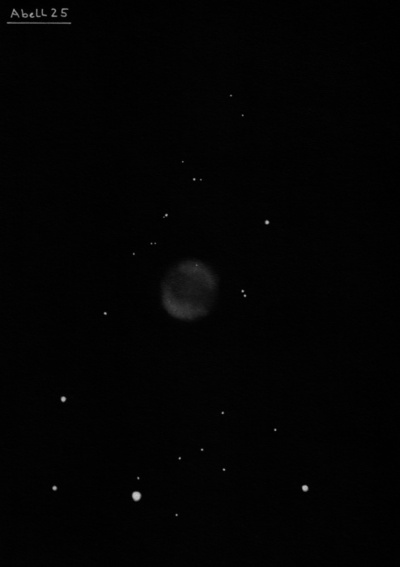
| Type | PN [3b] |
| RA | 08:06:46.5 |
| Dec | -02:52:35.0 |
| major_axis | 2.8' |
| mag | 15.4 |
| surface_bright | 17.4 |
HDW 5
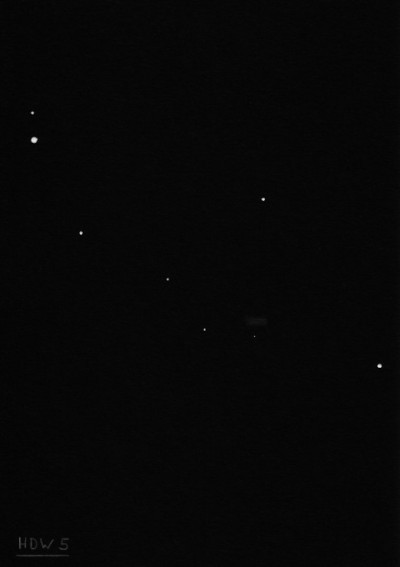
| Type | PN |
| RA | 06:23:37.2 |
| Dec | -10:13:24.0 |
| major_axis | 96.0'' |
| mag | 15.4 |
| surface_bright | 16.1 |
Abell 18
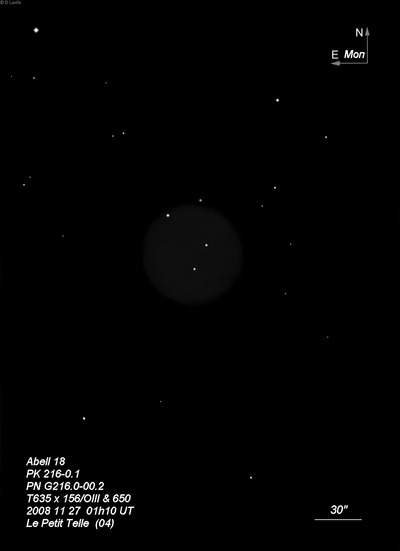
| Type | PN [2b] |
| RA | 06:56:14.7 |
| Dec | -02:53:08.0 |
| major_axis | 78.0'' |
| minor_axis | 66.0'' |
| mag | 17.5 |
| surface_bright | 17.7 |
Sh2-280
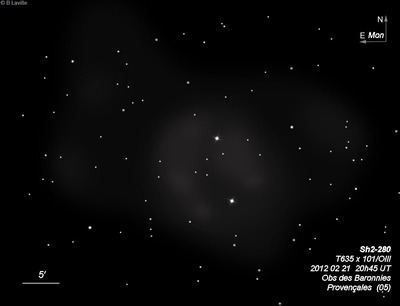
| Type | BN [HII] |
| RA | 06:34:19.2 |
| Dec | +02:32:29.0 |
| major_axis | 40.0' |